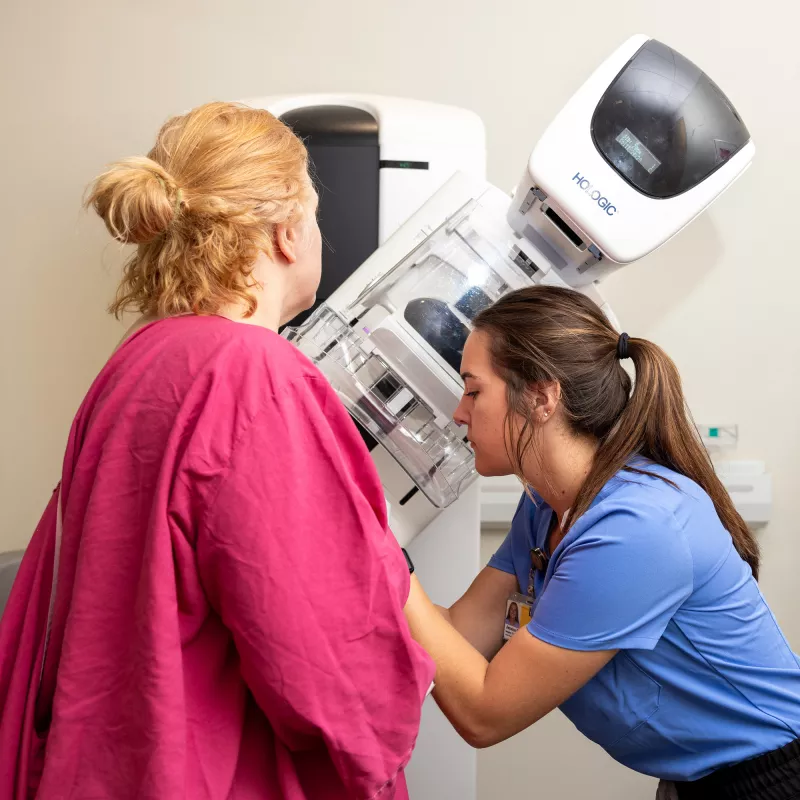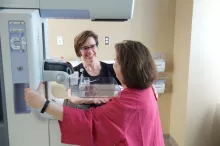How UI Health Care is making it easier to detect cancer in dense breasts
Contrast mammography can detect breast cancer unseen on a regular mammogram

About half of women over 40 years old have dense breasts according to the CDC. Why does this matter? Women with dense breasts have a higher chance of getting breast cancer. The denser your breasts are, the higher your risk.
In November 2023, our breast imaging team in the Department of Radiology began using contrast enhanced mammography as a diagnostic tool for selected patients who were recalled from a routine screening mammogram. Contrast enhanced mammography is particularly helpful in patients with dense breasts.
UI Health Care has the only medical center in Iowa to offer this technology, and our care teams have been able to spot cancers in areas where a regular mammogram fails to detect it.
What is contrast enhanced mammography?
Contrast enhanced mammography is a mammogram that uses iodinate contrast dye. The dye makes it easier to find the new blood vessels that form when the cancer grows. This formation of new blood vessels is known as neovascularization.
Our care teams currently use contrast enhanced mammography as a diagnostic tool, meaning patients must be screened with a regular mammogram before receiving contrast enhanced mammography.
“A patient will receive a screening mammogram, and we might see an abnormality,” says Fabiana C. Policeni, MD, breast imaging director. “We would call this patient for additional imaging and have contrast enhanced mammography done.”
Contrast enhanced mammography is only approved by the FDA for diagnostic studies. The utilization of contrast enhanced mammography for screening purposes is still under research investigation.
What patients are eligible for contrast mammography?
Patients can have normal risk, intermediate risk, or high risk for breast cancer.
“High risk patients are recommended to receive an MRI,” Policeni says. “However, these patients can also receive contrast enhanced mammography if there are any contraindications that bar them from having an MRI.”
Currently UI Health Care can only use contrast enhanced mammography for patients who had an abnormality on their initial screening.
This is especially beneficial for patients with dense breasts due to the limitations of traditional mammograms for these patients.
“Historically, patients with dense breasts have a more difficult mammographic interpretation,” Policeni says. “The ability to enhance the neovascularization of the tumor with contrast enhanced mammography addresses that problem by providing a better view of the area in denser tissue.”
Finding results in unexpected places
Since UI Health Care began using this diagnostic tool last year, our care teams have been able to spot surprising abnormalities.
In one instance, Policeni’s team called back a patient who had an abnormality in their initial screening. Contrast enhanced mammography didn’t show enhancement in that area, but Policeni’s team discovered an abnormality in a completely different spot.
“That abnormality had not shown up at all in the initial screening,” Policeni says. “We did a biopsy on this area, and it was cancer. That area would have been missed if we had not done contrast enhanced mammography.”
In other patients, contrast enhanced mammography has caught additional areas of neovascularization while also confirming the abnormality of the initial screening.

Leading the way
Since contrast enhanced mammography is so new, our breast imaging division is working to spread the word about its benefits and availability.
“It’s nice to be a pioneer in the state of Iowa for doing this,” Policeni says. “We want providers to know that we have this technology available for patients who would benefit from it.”

